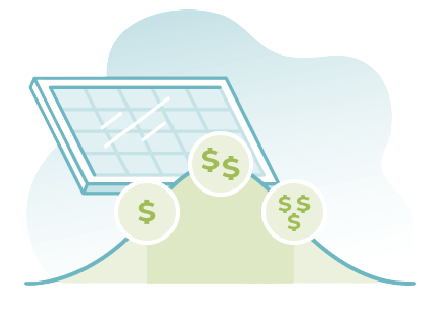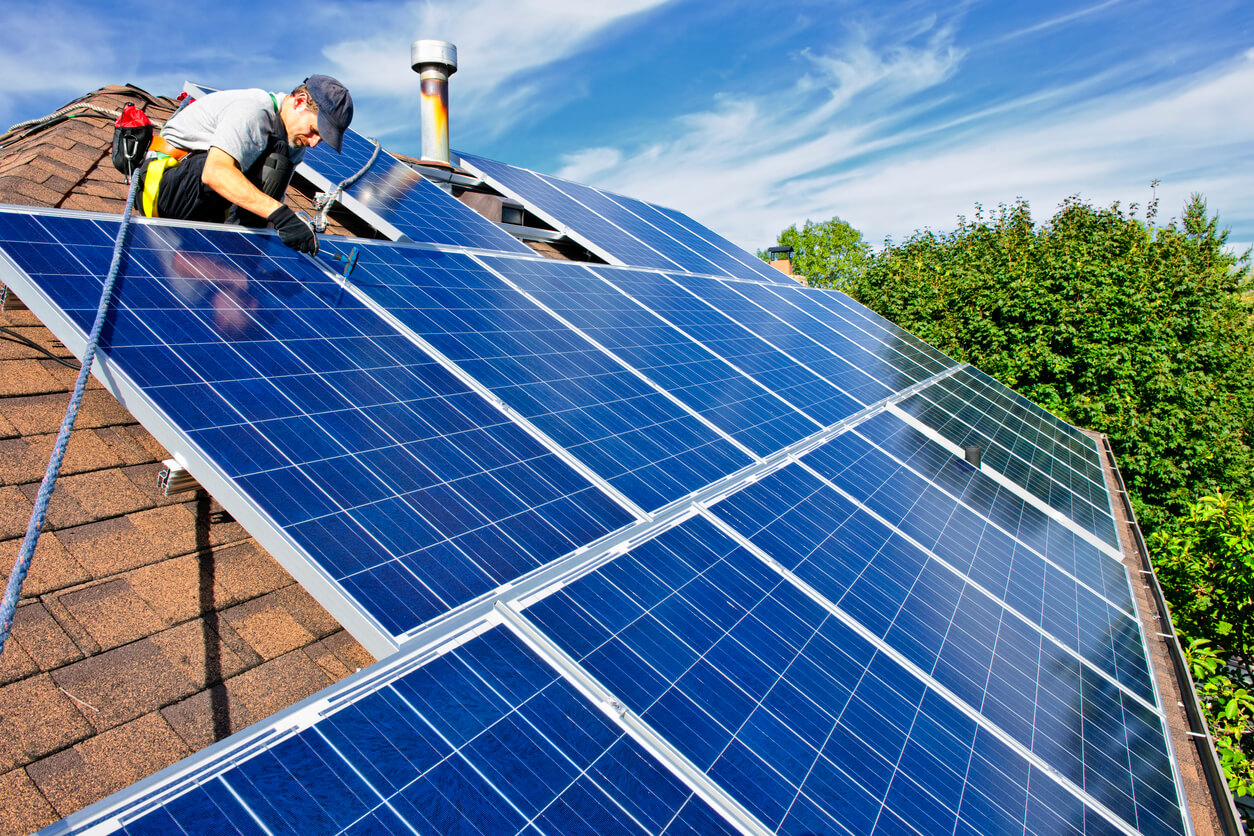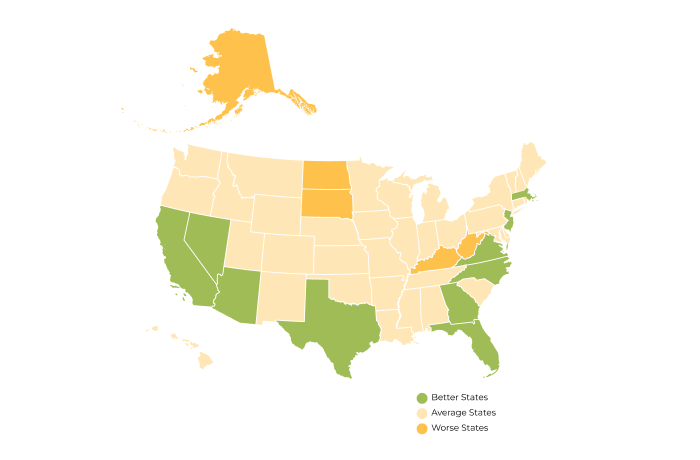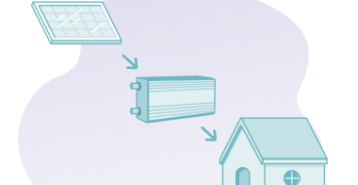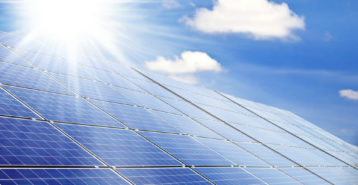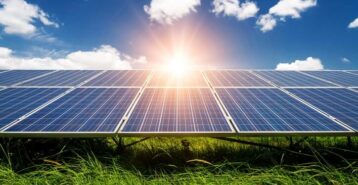As solar energy continues to gain traction across the country, prices continue to drop and solar panel installations become more accessible.
The Office of Solar Energy Efficiency and Renewable Energy reported a 70 percent drop in the price of solar PV panels since 2014. The U.S. Energy Information Administration said that the amount of solar power being used continues to climb dramatically.
With that said, the average cost of solar panels and installation ranges between $12,000 and $30,000. That wide range reflects a number of factors including the home’s geographical area, size, a home’s sun exposure, and energy usage.
The national average price for a 6-kilowatt (kW) solar energy system is about 10.55 cents per kilowatt-hour. For context, residential solar panels are usually sized at 3kW to 8kW. This is before factoring in potential tax incentives and rebates.
But what does all of that really mean? Here is our guide to a solar panel installation cost breakdown.
How Much Do Solar Panels Cost?
These are a few main factors that will determine exactly how much it will cost to install solar panels on your home.
Generally, it’s safe to estimate that it will cost about $16,500 to outfit a 1,500-square-foot home with solar panels.
You can use the above price as a starting point, and then get a general sense of your own cost by figuring it is $10 per square foot of home to add solar panels from there.
So, using that math, how much do solar panels cost for a 2,000 square foot house? The total comes to about $21,500. Using the same math, it would cost $11,500 for a 1,000 square foot home to install panels.
Ultimately, the price will depend mainly on two factors: your home’s sun exposure and electricity usage. Homes that are closer to the equator will more than likely have lower costs than those further away.
Though this is a good guideline, the only way to get an accurate cost for installation of solar panels is to get quotes from solar contractors.
Your Home’s Average Utility Costs and Energy Usage
The amount of energy used by your household will dictate the number of solar panels you will need to install. Homeowners can look at their electrical bills to calculate their daily average of energy usage and compare it to how many panels would be necessary to generate all of their energy needs.
Your Rooftop’s Solar Potential, or the Amount of Sun It Receives Yearly
The amount of sun exposure your home receives can impact how much energy is absorbed by the solar panels. In turn, this impacts how much money you are able to absorb from your existing electric bills.
The Average Local Cost For a Solar Panel System in Your Area
Where a homeowner lives can impact the local installation rate as well as the number of incentives and rebates available in the area.
The Average Labor Costs and Demand in Your Area
The average price of labor per watt across the country is about 50 cents, but it varies state-by-state.
Keep in mind that the cost to install solar panels also varies from state to state. However, according to the Department of Energy, the cost to install solar panels is dropping nationally year over year due to new solar energy initiatives. In the last decade, the cost of solar power has dipped by more than 80 percent.
According to the Solar Energy Industries Association, the top 5 states for solar installations are Texas, California, Florida, Virginia and Georgia.
Many states have also accelerated their relationships with solar energy. For instance, in 2019, Virginia ranked 19th but now sits in fourth place.
Compared to other home improvement projects, solar panels are a relatively high-cost project. But they can in turn raise a home’s market rate and, eventually, offset electricity bills. In general, solar panels begin to pay for themselves in small increments within the first year. Homeowners can expect broader payback offsetting between five and 15 years depending on the setup and where you live.
Is Your State a Good Place to Get Solar Panels?
Solar power is used in different capacities by homeowners across all 50 states, but some inevitably do better than others. That’s why where you live can play a critical factor when it comes to deciding if your home is a good candidate for solar energy.
According to a report released by the Solar Energy Industries Association (SEIA) in January and based on annual data collected throughout 2021, these are the top states for cumulative solar electric capacity installed.
- California: 34,950 megawatts
- Texas: 13,845 megawatts
- Florida: 8,206 megawatts
- North Carolina: 7,811 megawatts
- Arizona: 5,644 megawatts
- Nevada: 4,511 megawatts
- Georgia: 4,268 megawatts
- New Jersey: 3,854 megawatts
- Virginia: 3,761 megawatts
- Massachusetts: 3,607 megawatts
Like last year, California remains leaps and bounds ahead of the other nine states in terms of solar power. The state is able to power more than 10 million homes using solar power, compared to Texas, which is in second place and can power about 1.7 million homes. The Golden State was an early adopter of the technology and jobs generated by the industry.
According to the same Solar Energy Industries Association data, the worst states for solar energy are:
- North Dakota
- South Dakota
- West Virginia
- Alaska
- Kentucky
The low rankings are because of a combination of factors including less sunlight in some cases, reliance on coal facility-based labor (West Virginia), and long winters.
Solar Panel Installation Costs by Size
To get started estimating your own costs, reference our table below. Find your home’s closest square footage and check out the range of panels you may need and the cost for those panels.
| House Square Feet | How Many Panels You May Need | Total Cost |
|---|---|---|
| 1,500 | 15 to 18 | $14,000-$18,000 |
| 2,000 | 16 to 25 | $18,550 - $24,000 |
| 2,500 | 18 to 32 | $24,500 - $30,000 |
| 3,000 | 20 to 40 | $30,550 - $36,000 |
The panel number ranges depending on whether you live in a state that is better or worse for solar due to climate and whether or not you want to offset all your electricity needs or just a part of them.
How Many Solar Panels Will You Need?
To know how many solar panels you will need, you will want to determine how much electricity you use in your home daily.
Modernize recommends discussing these factors with a trusted solar contractor. For ease, bring your electric bills with you to a consultation. You can also calculate how much energy you use per day by taking your monthly kilowatt usage and dividing it by 30. For context, the average house in the United States uses about 900-kilowatt hours (kWh) a month—roughly 11,000 kWh a year.
Ultimately, the number of panels you purchase contributes toward the amount of kW of electricity produced each day. The more of your electricity costs you want absorbed by solar, the more panels you need. If you only want a portion of your power to be produced by solar, you won’t need as many panels.
Additional Solar Panel System Costs
There are a few things you’ll want to add to your solar energy system’s total cost to get the most accurate price estimate. Here are a few additional factors that will impact how much your solar panels will cost:
Labor Costs
Local labor costs for solar installation will change depending on your area and the average costs solar installers charge in your area.
Installing Solar Mounts
The costs to install the racks that hold your residential solar panels will affect the cost as well. You can choose from fixed mounts or tracking mounts on the ground, on poles, or, most commonly, on the roof.
Installing Solar Inverters
A solar inverter will need to be installed to transform direct current (DC) power from the panels into the alternating current (AC) you can use in your home
Other Costs
There may also be costs for any local permit fees, inspection fees, and taxes on the solar panels.
Fortunately, as more people adopt solar power, costs have fallen as a result — a trend that’s very likely to continue in the future. An analysis by the federal government’s National Renewable Energy Laboratory (NREL) discovered that installed prices have fallen at an average annual rate of 13% to 18%.
Always make sure to speak with a local solar professional to get a more accurate estimate of what your installation will cost.
What Size Solar Panel System Do You Need?
The average home uses 905 kWh per month, or around 10,850 kWh per year, in electricity. An average-sized home with a decent amount of sunshine could install a 5 kW to 6 kW solar panel system to help reduce utility bills.
You may want to learn about your sun number score for solar. It is calculated based on your home’s location and average sunlight exposure. Also, explore the different solar panel dimensions and sizes with your contractor for more context.
The larger the solar panel system you install for your home, the lower the cost per watt will be. The cost per watt is between $6 a watt and $8 a watt. That price includes solar panels, parts, labor costs, permits, and overhead.
With solar panels, the money you save on your electricity bills can more than earn back your initial installation costs. However, this takes seven to 20 years. Solar rebates and incentives can help speed up your return on investment. You may also be able to participate in selling excess electricity from your solar panels – a process known as net metering – in your area.
What is the ROI on Solar Panels?
You can calculate the return on investment for residential solar panel installation by calculating your total payback. Calculate the amount you spent to install a solar panel system and then figure out the amount you will save on energy bills monthly.
These two numbers show how quickly your savings will cover your initial costs. Electricity rates will vary by region, being higher in the Northeast than in the Northwest. Solar tends to be more cost-effective where electricity prices are high and sunshine is abundant.
In a March 2021 Modernize survey, 40 percent of homeowners said they are actively pursuing home improvement projects to save money on their utility and electric bills. Installing solar panels is an energy-efficient way to save money on energy bills for the long-term.
On the other side of the coin is your home’s resale value. A Zillow analysis showed that solar panels can increase a home’s value by up to 4.1 percent.
How Does Net Metering Work?
In states where net metering is in effect, consumers can sell the excess solar energy they produce back to their local utility.
According to Solar Reviews, homeowners in Delaware, New Hampshire, Oregon, and Washington, D.C. can take the best advantage of net metering. This is because of a combination of factors including policy, inclusion fees, and rollover policies.
A digital meter on your house records electricity moving in either direction as it comes into the house and as it leaves. The “net” part of the term means that the homeowner pays the “net” amount for the electricity used by the house minus the extra sold back to the grid.
Should You Lease Solar Panels?
There are several payment options that bundle residential solar installation costs into a consumer’s electric bill, either as a solar panel leasing option or as a power purchase agreement (PPA).
Solar leases allow the homeowner to install solar panels without paying anything (or much) up front. After the panels are installed, the homeowner pays only a flat monthly fee. The fee includes the installation costs, which are spread out over time, and the cost of electricity supply.
-
Pros
- Lower out-of-pocket cost
- Third-party financing
- Immediately cash-flow positive
-
Cons
- Homeowner does not keep incentives
- May make home harder to sell
- Paying monthly fee for panels
Advantages
These types of third-party financing arrangements have a lot of benefits for consumers—the best being no large out-of-pocket investment. And the solar system becomes cash flow positive from day one. Not surprisingly, these agreements have been a big factor in driving today’s solar energy installation boom.
Disadvantages
It is worth noting that under most solar lease arrangements, the solar company usually keeps any incentives associated with owning solar panels. But the consumer gains other advantages. The solar company may offer a monthly fee below the utility rate, or one that doesn’t rise as utility rates do. At the end of the contract, homeowners can renew, purchase the system, or have the solar panel equipment removed.
If you decide to sell your home, having leased solar panels can actually work against you. You would need to transfer over your lease to a qualified buyer. So, of course, you would have to ensure the person making an offer on your home is qualified in the first place.
Many homebuyers would rather not deal with that extra paperwork. This makes homes with solar leases sit on the market longer than homes where the solar panels are owned.
Residential solar installation may be simple in concept, but in application, it can be bewildering. And the best approach for one homeowner isn’t necessarily the best for another.
Take the time to gather information about house size, local solar insolation, existing electric rates, and consumption. It’s worth it in figuring out your potential solar cost for your home.
Compare top-rated solar pros in your area.
Read real homeowner reviews, explore qualifications, and view promotions. Modernize makes it easy to browse professionals and find one that will be perfect for your project.
